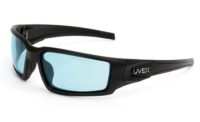It’s vital to provide individuals with the anti-fog (AF) lens coating that meets the rigors of the job. But an effective AF coating is only as good as they eyewear it’s on. If workers are uncomfortable in their fog-free eyewear, they’re likely to remove it.
Experts agree that 90 percent of our nation’s 700,000 annual occupational eye injuries could be avoided by wearing the proper safety eyewear. Fog, fit, comfort and style all play important roles in workers’ ability to wear their eyewear all shift long and stay protected. This article looks at key considerations in selecting the AF coating that stands up to the fogging hazards your workforce faces, on safety eyewear they’re willing to wear all day long.
Premium anti-fog
Fog occurs whenever the environment is hot or humid, when workers transition between cool and warm temperatures (i.e. air conditioning to outdoors), and when workers exert themselves. In the summer workers commonly face more than one of these factors, making lens fogging nothing less than a sure bet.
The need for reliable, long-lasting anti-fog lens coating is obvious, but until recently it’s been challenging to find effective solutions. Advances in AF chemistry and application processes have garnered significant breakthroughs. Today, innovative coating technologies manipulate moisture through surface-acting agents: chemicals designed to move to the lens surface as needed to prevent fogging. Some coatings employ hydrophilic properties, which absorb moisture into the lens, while others use hydrophobic properties to spread excess condensation in a clear film over the lens surface and ultimately shed moisture from the lens. Some premium coatings employ dual-action properties, utilizing both hydrophilic and hydrophobic chemistries to deliver exceptional performance.
Look for manufacturers that permanently adhere AF coating to the lens using an intense curing process. Only permanent coating will deliver consistent fog-free performance even after frequent wear, wiping and washing. Manufacturers that employ controlled application methods and vigorous product monitoring ensure smooth, consistent results on every pair of eyewear. Finally, while there is no anti-fog performance standard in the U.S., look for manufacturers that meet – or preferably exceed – Europe’s stringent EN 166 and EN 168 safety standards which include proven resistance to fogging of oculars. Keeping fog out of sight with premium AF coating promotes compliance, enables a safe, clear view and allows workers to carry out tasks uninterrupted.
Basic coverage
Basic anti-fog coating may suffice where the risk of fog is low: environments in which there’s insignificant heat or humidity, temperatures remain consistent and worker exertion is minimal. It can also be ideal for protecting America’s sizable (and growing) part-time workforce, where high volumes of eyewear are employed and cost is a key factor. Basic AF coverage allows workers to leave eyewear on longer, without the dangerous effects of obscured vision or removing eyewear to wipe it clear.
Promote all-day wear
Now that you’ve selected a reliable anti-fog lens coating, your workers will leave their safety eyewear on all shift long, right?
Wrong.
When workers’ eyewear fits poorly, feels uncomfortable or workers don’t like how it looks, they are likely to remove it – even in the presence of hazards. Anti-fog lens coating is only as useful as the safety eyewear it’s on. If workers remove their AF eyewear due to discomfort, they are unprotected.
Safety eyewear should deliver a safe, snug fit so it stays in place upon impact. But every individual has a unique set of head and face measurements, so a safe and comfortable fit for one may be unsafe or uncomfortable for another. Poorly fitting eyewear can slip down the nose and require constant repositioning, or cause painful pressure on the nose or behind the ears, which can lead to headaches and lost productivity.
To find the perfect fit for everyone in your workforce, look for comfort features such as padded nose bridges, padded temples, and multi-material solutions that deliver a soft, no-slip grip. Wrap-around styles that flex can conform comfortably to narrow and wide facial profiles alike. For a customizable fit, look for styles with innovative adjustability features such as wire-core temples and ratcheting lens angles.
Finally, don’t overlook the importance of style in supporting compliance. To encourage all-day wear, look to modern sport-inspired or sunwear styles that look as good on the job as they do at play. When you incorporate attractive styling into your safety eyewear line-up, workers will wear their protection with confidence. Today you can find a variety of anti-fog coatings available on nearly any style of safety eyewear to best suit the needs of your workforce.


